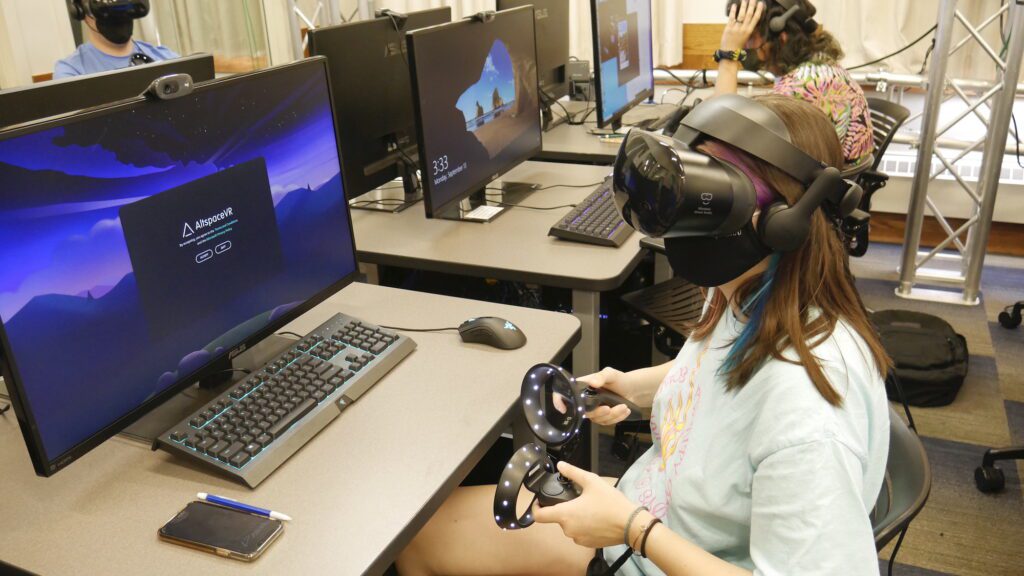The use of virtual reality (VR) tools in game development is transforming the immersive experience of playing games. Popular game engines like Unity, Unreal and CryEngine offer powerful tools and user-friendly interfaces to developers for creating realistic virtual worlds, characters and physics. Unity’s terrain and particle system enable players to explore realistic environments and weather effects that can enhance the immersion of the game. Unreal Engine offers advanced physics and lighting tools for creating realistic interactions between characters and virtual objects, while CryEngine offers specialized tools for creating realistic water currents and weather effects. These VR game development tools offer players an incredibly immersive gaming experience.
Virtual Reality Tools in Game Development: Creating Immersive Gameplay
Introduction
Virtual reality (VR) is revolutionizing the way games are developed and played. Gamers can now immerse themselves in a world where they feel as though they are actually a part of the game. VR technology has evolved dramatically in recent years, with many tools and platforms now being used to create games that offer a truly immersive experience. In this article, we will explore some of the virtual reality tools used in game development, and how they can be used to create immersive gameplay.
Unity
Unity is a well-known game engine that has been used to develop a vast array of games, from first-person shooters to puzzle games. Unity has also become a popular choice for VR game development, thanks to its user-friendly interface and powerful tools for creating immersive worlds.
One way in which Unity is used to create immersive gameplay is through the creation of realistic environments. Using Unity’s terrain tools, developers can sculpt and shape environments to provide a realistic world for players to explore. With the help of Unity’s particle system, developers can also create realistic weather effects that can add to the overall immersion of the game.
Unity also offers a number of asset store plugins that can be used to create realistic characters and animations. These plugins can be used to create realistic facial expressions, body movements, and animations that can help immerse the player in the game.
Unreal Engine
Unreal Engine is another popular game engine that has been used to create a number of AAA games, including Fortnite, Gears of War, and Unreal Tournament. Similar to Unity, Unreal Engine has also become a popular choice for creating VR games.
One way Unreal Engine is used to create immersive gameplay is through the creation of realistic physics. Unreal Engine’s physics engine allows developers to create realistic interactions between characters and objects in the game world. For example, if a player were to push a box in the game world, the box would respond realistically based on its weight and the force applied.
Unreal Engine also offers a number of powerful tools for creating realistic lighting and shadows. This can be used to create a realistic world that can help immerse the player in the game.
CryEngine
CryEngine is a lesser-known game engine that has been used to create a number of popular games, including Crysis and Ryse: Son of Rome. CryEngine has also become a popular choice for creating VR games, thanks to its powerful tools for creating realistic environments.
One way in which CryEngine is used to create immersive gameplay is through the creation of realistic water and underwater environments. Using CryEngine’s water and underwater system, developers can create realistic waves and currents, as well as underwater plants and creatures.
CryEngine also offers a number of powerful tools for creating realistic weather effects, such as rain, snow, and fog. These weather effects can help add to the overall immersion of the game, and make the player feel as though they are actually in the game world.
Conclusion
Virtual reality is changing the way games are developed and played, and the use of powerful VR tools is key to creating immersive gameplay. Unity, Unreal Engine, and CryEngine are just a small selection of the powerful tools available for creating VR games. By using these tools to create realistic environments, characters, and physics, developers can create games that offer a truly immersive experience for players.
